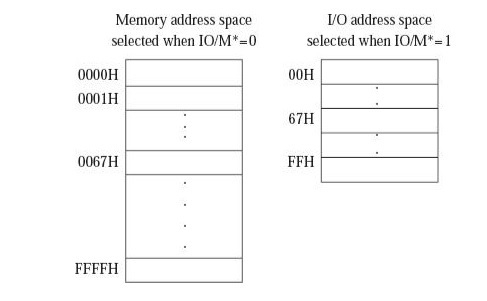
 Data Structure
Data Structure Networking
Networking RDBMS
RDBMS Operating System
Operating System Java
Java MS Excel
MS Excel iOS
iOS HTML
HTML CSS
CSS Android
Android Python
Python C Programming
C Programming C++
C++ C#
C# MongoDB
MongoDB MySQL
MySQL Javascript
Javascript PHP
PHP
- Selected Reading
- UPSC IAS Exams Notes
- Developer's Best Practices
- Questions and Answers
- Effective Resume Writing
- HR Interview Questions
- Computer Glossary
- Who is Who
Comparison of memory-mapped I/O and I/O-mapped I/O
In Memory Mapped Input Output −
We allocate a memory address to an Input-Output device.
Any instructions related to memory can be accessed by this Input-Output device.
The Input-Output device data are also given to the Arithmetic Logical Unit.
Input-Output Mapped Input Output −
We give an Input-Output address to an Input-Output device.
Only IN and OUT instructions are accessed by such devices.
The ALU operations are not directly applicable to such Input-Output data.
So as a summary we can mention that −
I/O is any general-purpose port used by processor/controller to handle peripherals connected to it.
I/O mapped I/Os have a separate address space from the memory. So, total addressed capacity is the number of I/Os connected and a memory connected. Separate I/O-related instructions are used to access I/Os. A separate signal is used for addressing an I/O device.
Memory-mapped I/Os share the memory space with external memory. So, total addressed capacity is memory connected only. This is underutilisation of resources if your processor supports I/O-mapped I/O. In this case, instructions used to access I/Os are the same as that used for memory.
Let's take an example of the 8085 processor. It has 16 address lines i.e. addressing capacity of 64 KB memory. It supports I/O-mapped I/Os. It can address up to 256 I/Os.
If we connect I/Os to it an I/O-mapped I/O then, it can address 256 I/Os + 64 KB memory. And special instructions IN and OUT are used to access the peripherals. Here we fully utilize the addressing capacity of the processor.
If the peripherals are connected in memory mapped fashion, then total devices it can address is only 64K. This is underutilisation of the resource. And only memory-accessing instructions like MVI, MOV, LOAD, SAVE are used to access the I/O devices.


